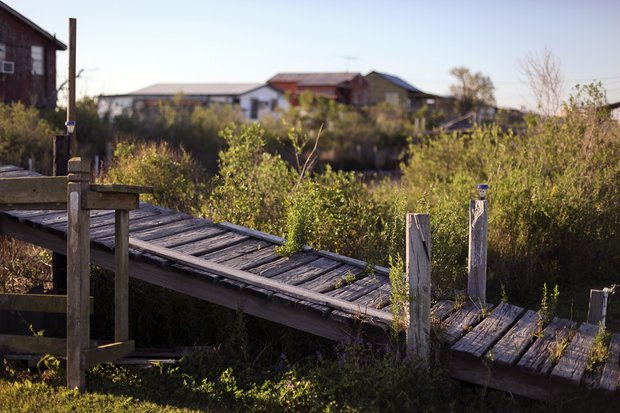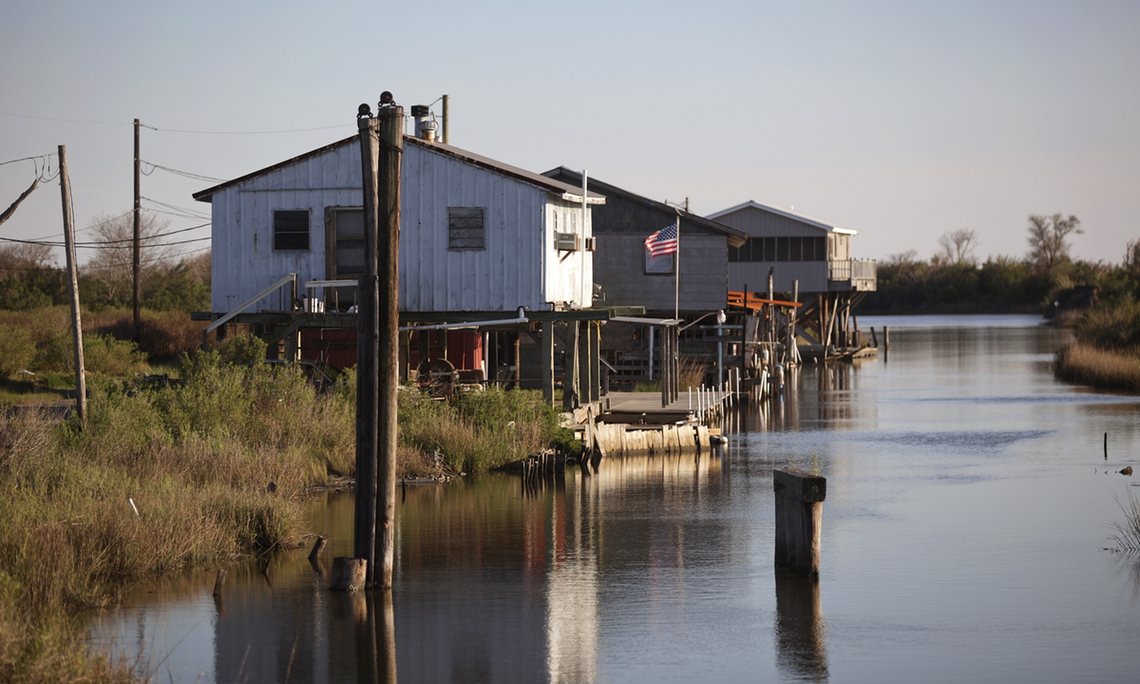THE LUCKY ONES: NATIVE AMERICAN TRIBE RECEIVES $48 M TO FLEE CLIMATE CHANGE
In Louisiana, the Biloxi-Chitimacha-Choctaw tribe has been awarded a natural disaster grant to resettle away from their sinking land. But other indigenous Americans have no way out
The Biloxi-Chitimacha-Choctaw tribe in Louisiana has found money to relocate due to the impact of climate change. Others aren’t so lucky.
Photograph: Charlie Varley for the Guardian
Autumn Spanne THE GUARDIAN
The tiny Biloxi-Chitimacha-Choctaw tribe has called the coastal marshlands of southern Louisiana home ever since their ancestors settled there to avoid forced relocation under the Indian Removal Act of 1830. But the close-knit community of Isle de Jean Charles has grown increasingly fragmented as their island slowly disappears beneath their feet and powerful storms ravage their homes and crops.
A potent combination of accelerating sea level rise, salt water intrusion and subsidence of the land has caused devastating erosion and flooding, exacerbated further by regional oil and gas development and the shipping industry. Today, less than a quarter of the original inhabitants still live on the island, which has lost 98% of its landmass since the 1950s. Most inhabitants resettled in nearby parishes, but even the few miles distance have diminished cultural knowledge long nurtured by the relative isolation of island life.
As the waters swallowed Isle de Jean Charles decade by decade, the tribe reluctantly began to face the possibility of another relocation. Only this time, they would set the terms. In 2000, they began drafting a plan to resettle on the mainland, in a location that would offer protection from hurricanes and flooding yet allow them to maintain their cultural identity, including access to traditional fishing and agriculture. The plan doesn’t force anyone to leave the island. Some residents say they won’t go, although it’s unclear how much longer their homes will remain standing before the water completely consumes the land.
In January, the US Department of Housing and Urban Development (HUD) awarded $48m for a resettlement plan, part of an initiative to help communities stricken by natural disasters. It makes Isle de Jean Charles one of the first communities in the lower 48 states to undertake a complete relocation due to climate change. HUD, the state and the tribe hope the Biloxi-Chitimacha-Choctaw plan will become a model for other tribes and communities facing imminent climate threats.
But while the relocation plan and funding are celebrated as an important precedent and possible roadmap for future relocation projects, this level of support isn’t likely to be available to other tribes seeking funding and guidance for climate-related displacement and resettlement.
As climate change heats up, Arctic residents struggle to keep their homes
The HUD grant was a one-time award, part of a $1bn Natural Disaster Resiliency Competition. While the agency has other programs for federally-recognized tribes to undertake relocation, they are not intended to cover resettlement of an entire community, says Marion McFadden, deputy assistant secretary of grants at HUD.
Government disaster programs generally support individual, not collective, relocation projects. But this approach doesn’t consider the cultural disruptions that occur when native peoples must relocate in a piecemeal manner, says Julie Maldonado, an anthropologist and lecturer at the University of California, Santa Barbara and a lead author of the 2014 National Climate Assessment chapter on indigenous peoples.
Advertisement
In fact, she says, there is no single government entity or framework designated to provide tribes imminently threatened by climate change with support navigating the complex, costly process of community relocation.
From Alaska to the Pacific Northwest to the Gulf Coast, hundreds of tribal communities are now grappling with how to protect their safety, economic sustainability and cultural integrity as climate change combines with other social, economic and environmental factors to threaten their way of life.
In Oregon and Washington, warming streams and changes in the seasonal water cycle threaten traditional salmon grounds, and coastal tribes like the Tulalip, Swinomish and Hoh also face recurring damage from flooding and sea level rise. In the Southwest, Pueblos like Santo Domingo are altering their traditional irrigation methods in the face of prolonged drought, while some wells and livestock watering holes on the Navajo Nation have gone dry. Meanwhile, Florida’s Seminole and Miccosukee tribes are confronting a future of sea level rise in the Everglades that threatens homes, drinking water and cultural resources.
Traditionally, many tribes adapted to weather extremes and seasonal patterns by migrating temporarily. But reservation boundaries and encroaching development make that virtually impossible today, which can prompt urban migration that further weakens connections to traditional culture and community.
“Often climate change is impacting people who have already been placed in vulnerable situations, who have already been marginalized and pushed to the fringes,” says Maldonado. “They’ve still been able to adapt and cope and make changes and survive. And what happens is that climate change can act as a kind of a tipping point in that scenario.”

The disappearing bayou in Louisiana, where land is rapidly consumed by erosion from the Gulf of Mexico. Photograph: Charlie Varley for the Guardian
Most tribes are opting to adapt by reinforcing existing infrastructure: building seawalls, elevating their homes, combining traditional ecological knowledge and scientific modeling to anticipate how their lands, culture, economy and public services are likely to be affected.
Advertisement
But those who make the difficult decision to relocate are entering largely uncharted territory. State and federal programs, where they exist at all, concentrate on disaster relief and rebuilding. There is no clear government funding mechanism to preemptively relocate an entire community or partner with tribal counterparts in the way that HUD and Louisiana are doing with Isle de Jean Charles.
Further complicating matters, many federal programs require applicants to be federally-recognized tribes. For the approximately 400 tribes, including the Biloxi-Chitmacha-Choctaw, that are not officially recognized by the federal government, funding options are much more limited. When Isle de Jean Charles first began exploring avenues to fund their resettlement plan, it soon became a complex patchwork of funding sources, each with its own distinct – and sometimes competing – requirements.
“You can apply for a Department of Energy grant for your solar system,” says Chantel Comardelle, the tribe’s executive secretary. “But you need different funders for purchasing the land and having the infrastructure for your solar, so it’s a lot of putting in for different resources to pay for different things.”
Receiving the HUD grant allowed the Biloxi-Chitmacha-Choctaw to quickly move ahead with their plan without worrying about stitching together disparate sources of funding. Even though other tribes aren’t likely to receive full funding from a single source, Comardelle thinks some – particularly smaller tribes like hers – could benefit from more centralized support.
“I think you would almost have to create a sort of climate change resettlement division, to where they could say, ‘OK, you bring us your plan, and we will help you find the resources – this is the funding for this, this is the funding for that, and help give clarity with this process’,” says Comardelle.
That’s something that would help Native American villages in Alaska struggling through a long, fraught relocation process. In Alaska, warming is occurring at more than twice the rate of the US mainland, causing earlier snow melt, vanishing sea ice and rising ocean temperatures. Dozens of indigenous communities are in imminent danger from coastal flooding and erosion, according to a 2009 report by the US Government Accountability Office.
One of the most threatened is the Yup’ik village of Newtok in western Alaska, where the combination of diminishing Arctic sea ice, thawing permafrost and extreme weather events are causing severe erosion and flooding that threatens homes and their drinking water. It is increasingly difficult to get essential supplies like fuel into the village, which is only accessible by plane and boat.
“It’s very scary right now,” says Andy Patrick, former president of the Newtok Traditional Council. “We’ve got the flooding, eroding and sinking of the community. The village is sinking very fast, the permafrost is melting and there’s no way that we can prevent this happening.”
Newtok voted 20 years ago to relocate. The village secured a piece of land on higher bedrock ground through a land swap with the US Fish and Wildlife Service in 2003, still within reasonable proximity to their traditional hunting lands. Since then, however, there’s been scant progress.
Its lack of roads makes moving the village difficult – and expensive. Discrete funding programs are available through the Federal Emergency Management Agency, the Bureau of Indian Affairs and other federal entities. But there is no dedicated, comprehensive program to pay for relocation or help coordinate the process. A tribal leadership struggle further complicated the relocation effort.
In Washington, the Quinault Indian Nation is also planning to relocate a major population center in the face of sea level rise, warmer temperatures and increasingly destructive storms. The tribe occupies more than 200,000 acres and 23 miles of Pacific coastline on the southwestern end of the Olympic Peninsula.
In 2014, a storm surge breached a seawall and flooded the historic lower village of Taholah, which lies at the confluence of the Pacific Ocean and the Quinault River. Some 700 people – about 20% of the tribe’s population – live in lower Taholah, which is also the site of a tribal school and Head Start, senior housing center and a jail.
Quinault received a $700,000 grant from a tribal program at the US Department Health and Human Services to develop a relocation plan. The grant is a drop in the bucket compared to estimated $65m needed to develop the new village over the next decade.
Louisiana’s vanishing island: the climate ‘refugees’ resettling for $52m
Read more
Last week, Quinault President Fawn Sharp testified before the House Appropriations Subcommittee on Interior and Environment that the federal government had fallen short of its treaty obligations when it came to tribal funding. Quinault, she said, had spent $4.4m of its own money to compensate for federal funding lapses – money it needed for other pressing matters, including climate adaptation and relocation.
“It would be helpful for the entire federal government to elevate the need to respond to climate change to the top of its priority list, and to assure, without question, that the resources are available – directly to tribes – to adapt to its impacts,” Sharp told the Guardian in an email this week. Sharp is also vice president of the National Congress of American Indians, an indigenous rights organization.
Back in Louisiana, the Biloxi-Chitimacha-Choctaw reject the label of “climate refugees” that some have attached to them. They consider themselves a forward-looking, sovereign people taking charge of their destiny in the face of significant environmental change – something others might learn from, says Maldonado.
“You’re talking about people who are employing a sense of agency, who still are empowered in their decision-making and are working to stay together. These terms get thrown out there and there’s this idea of the canary in the coal mine, but they’re not the canary in the coal mine – they’re showing us how to get out.”








Follow Us!